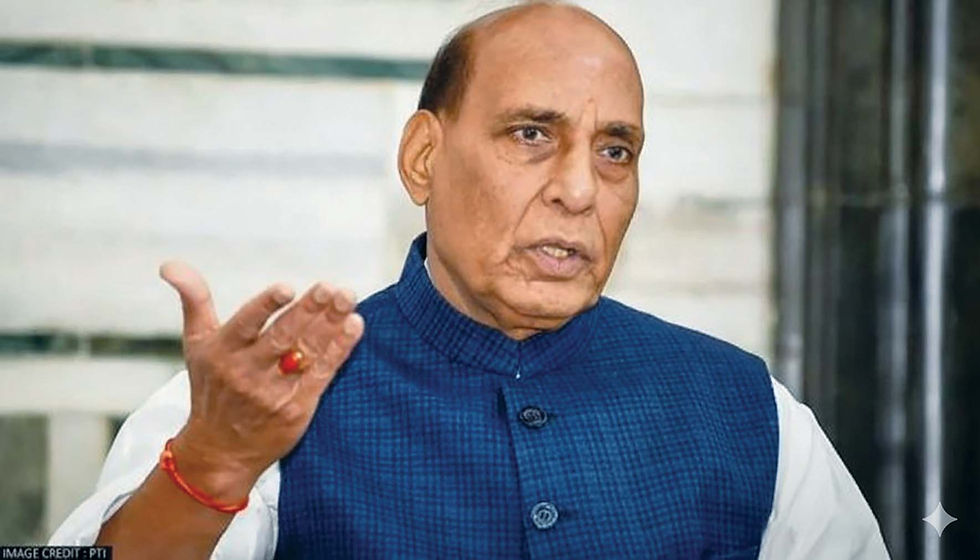India’s Defence Dilemma: Big Ambitions, Tight Purse Strings
- Amey Chitale

- Mar 26
- 3 min read
Despite rising threats and geopolitical gains, inadequate R&D and capital investment continue to undermine India’s military preparedness.

Over the past year, India’s defense landscape has evolved significantly. Diplomatic talks and disengagement agreements with China have eased tensions in Ladakh. The armed forces remain vigilant, with an enhanced focus on infrastructure development. Infiltration issues on the western border with Pakistan persist, while ethnic conflict in Manipur and the civil war in Myanmar require dedicated forces along the Indo-Myanmar border.
India’s defence budget for 2025-26 stands at Rs. 6.8 trillion, up 6 percent from the previous year. While the budget has grown 2.5 times over the past decade, its share of total spending has declined from 17 percent to 13 percent. At 1.9 percent of GDP, India’s defence outlay remains modest by global standards. Capital expenditure at Rs. 1.92 trillion has shrunk as a share of the total budget. Despite a four-fold rise over the decade, funding remains inadequate.
The Border Roads Organization has been allocated Rs. 7,143 crores for developmental works and Rs. 5,139.55 crores have been earmarked for establishment capex. The major components of the capex budget include Rs. 48,614 crores earmarked for aircraft and aero-engines, Rs. 63,099 crores for modern equipment, Rs. 11,452 crores for construction works and Rs. 24,391 crores for the naval fleet. Except for a 20 percent increase in the allocation for aircraft and aero-engines, funding for other categories remains flat.
The capex budget consists of two components: committed liabilities and new schemes. Committed liabilities are payments for contracts from previous years, while new schemes are projects likely to incur costs in the next financial year. From 2016-17 to 2019-20, the capex budget was insufficient to cover committed liabilities, raising concerns from the Standing Committee of Parliament. A proposed fund to address this issue has not yet been established, causing significant delays in execution.
The core revenue budget of Rs. 3.28 trillion includes allocations of Rs. 2.07 trillion for the Army, Rs. 0.38 trillion for the Navy, Rs. 0.54 trillion for the Air Force, and Rs. 0.12 trillion for DRDO. The Defence Ministry’s total salary bill is Rs. 1.68 trillion, accounting for 51 percent of the core revenue budget. The Army spends 60 percent of its budget on salaries, while the Navy, Air Force and DRDO spend 39 percent, 42 percent, and 44 percent, respectively. Balance funds are towards maintenance, upkeep, and operational needs. The non-core revenue budget of Rs. 1.60 trillion is entirely meant for pension bills. The introduction of the One Rank One Pension scheme has led to a significant increase in pension spending over the last decade.
The budget allocation for DRDO has decreased from 4.7 percent of the defence budget in 2014-15 to 3.9 percent in 2025-26, which is insufficient for significant R&D in emerging technologies. In contrast, China and the US allocate 15 percent to 18 percent of their budgets to R&D. Additionally, several DRDO projects have faced significant delays. Notably, the Tejas Light Combat Aircraft, initially expected to join the fleet in the 1990s, was only inducted in 2016. Similarly, Project 75, aimed at inducting six submarines by 2017, was completed only in December 2025.
India’s defense ambitions remain stymied by shrinking R&D and inadequate capital investment. The Air Force, meant to field 42 squadrons, operates just 31, hobbled by an aging MiG fleet and delayed acquisitions. While recent deals for Rafale jets and S-400 missiles signal a shift, reliance on imports persists as 30 percent of modernization funds flow abroad.
The government’s push for self-reliance under AtmaNirbhar Bharat has spurred defense exports, now at Rs. 21,083 crores, with a Rs. 50,000-crore target by 2028-29. Yet, India’s 0.2 percent global share underscores its struggle to carve a foothold in the arms trade.
India has made significant economic progress recently. As a developing nation focused on bolstering internal ecosystems, there are constraints on increasing defense spending. However, increasing R&D spending is essential. Pension liabilities are a significant burden, and the government should consider funded pension schemes for defense personnel to alleviate future burdens. Additionally, a non-lapsable capex corpus should be introduced to utilize unspent capital in future years.
India has emerged as a formidable player in the geopolitical arena, with strong foreign relations and increased acceptance as a strategic partner, thereby reducing defense vulnerabilities. However, without bolstering our capabilities, goodwill alone won't safeguard us in emergencies. Developing strategic defense capabilities is indispensable for the Viksit Bharat mission to become a reality.
(The author is a Chartered Accountant with a leading company in Mumbai. Views personal.)





Comments